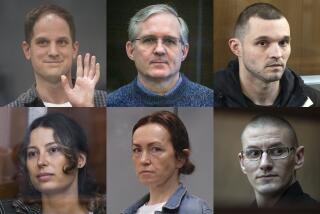U.S. Mission in Moscow Hires Locals : Embassy: Russians report to work for the first time in six years. This signals increased trust between the two nations.
MOSCOW — Russians reported for their full-time jobs at the U.S. Embassy in Moscow this week for the first time since 1986, and for Andrei Permyakov, the day marked the beginning of his “American dream.”
Although he graduated from the prestigious Moscow University and has worked as a translator and project manager for private Russian firms, Permyakov is starting out as a driver at the embassy.
For the record:
12:00 a.m. April 10, 1992 For the Record
Los Angeles Times Friday April 10, 1992 Home Edition Part A Page 3 Column 6 Metro Desk 1 inches; 25 words Type of Material: Correction
Moscow Embassy--In Thursday’s editions, a photo accompanying a story on the U.S. Embassy in Moscow was incorrectly credited. The photographer was Sergei Kivrin, for The Times.
“I understand that the role of a driver is not the highest post, but I hope to work my way up,” the 24-year-old Permyakov, who calls himself Andrew, said confidently in workable English. “You’ll see that Russians too can capture the American dream--start at a low-level job and move up, up, up.”
Only seven Russians started work at the Moscow embassy on Monday, but there are plans to have 50 Russians employed as translators, drivers, maintenance workers and clerical personnel by the end of July, according to John Ohta, the embassy spokesman.
Bringing full-time Russian employees back into the embassy compound signals a new relationship of increased trust between Moscow and Washington and also the intention to beef up the embassy staff to handle the $24-billion package of international aid that President Bush announced last week, U.S. diplomats said.
The Soviet government withdrew the more than 200 Soviet workers--cooks, typists, drivers, mechanics, repairmen and cleaning help--from the embassy in October, 1986, to retaliate for the U.S. expulsion of Soviet diplomats from the U.N. mission.
But after a string of spy scandals and the discovery that the new embassy building, which was built by Soviet workers, was full of listening devices, American diplomats all but applauded the move.
U.S. Ambassador Jack F. Matlock Jr., the last U.S. ambassador to Moscow, as late as 1988 called the pullout of Russian employees “the best thing that ever happened to us” and declared that “only over my dead body” would they return.
Security at the embassy was tightened after highly publicized incidents of U.S. Marine guards giving away secrets to local women with whom they were romantically involved. But since U.S. Ambassador Robert S. Strauss took over the helm last summer, security has eased. In his first news conference, Strauss declared his intention to review the stringent security relations that had kept U.S. diplomats from having close contact with Russians.
There are, however, strict rules governing the actions of the new Russian employees. Thick tape in green, yellow or red has been put across every door at the embassy, including a long red stripe across the glass doors leading to the cafeteria.
“Green means you can go in,” said Rashan Ryakhimov, 22, another new Russian employee. “Yellow means you can enter only with an escort, and red means don’t even think about it.”
Being found on the other side of a door with a red stripe, Ryakhimov said, means instant dismissal.
“It’s quite natural,” said Ryakhimov, who wore a watch with U.S. and Soviet flags on the face. “It’s a reality that for 73 years our countries were enemies. It’s quite hard to become friends all at once.”
Ryakhimov, who has a sparkling personality and speaks good English, said he too hopes to use his job as a furniture mover to catapult himself to a better position.
“The embassy officials said that there is a very good possibility for us to get higher-level jobs,” said Ryakhimov, a folk guitarist who is studying law in the evenings. “As the very first Russian employees, we are in a good position.”
Having over-qualified workers at the embassy is nothing new.
After the Soviet employees were withdrawn, the State Department decided to hire American contract workers. Soon there were young men and women with graduate degrees from Ivy League colleges who wanted to be in Moscow, performing manual work at a high cost to U.S. taxpayers.
The average cost to the government per person for the U.S. support staff at the embassy is $120,000 a year, said an embassy worker who asked not to be named.
“We will save money in the long run because we won’t have to replace the American workers or hire more,” Ohta said.
Ryakhimov’s monthly salary, in comparison, is 2,600 rubles plus $40, or a total of about $66 at the current exchange rate.
Although the salary is ridiculously low by American standards, Ohta said the pay was determined through a study of current salaries for Russians working at foreign businesses in Moscow.
“This is a really good salary,” Ryakhimov said with a grin. “It’s more than (First Deputy) Prime Minister (Yegor T.) Gaidar makes!”
More to Read
Sign up for Essential California
The most important California stories and recommendations in your inbox every morning.
You may occasionally receive promotional content from the Los Angeles Times.










